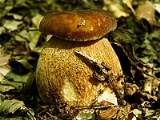
Boletus reticulatus
Encyclopedia
Boletus reticulatus and commonly referred to as the summer cep is a basidiomycete fungus of the genus
Genus
In biology, a genus is a low-level taxonomic rank used in the biological classification of living and fossil organisms, which is an example of definition by genus and differentia...
Boletus
Boletus
Boletus is a genus of mushroom, comprising over 100 species. The genus Boletus was originally broadly defined and described by Elias Magnus Fries in 1821, essentially containing all fungi with pores...
. It occurs in deciduous forests of Europe where it forms a symbiotic mycorrhiza
Mycorrhiza
A mycorrhiza is a symbiotic association between a fungus and the roots of a vascular plant....
l relationship with species of oak (Quercus). The fungus produces fruiting bodies in the summer months which are edible and popularly collected.
It was formally described by Jacob Christian Schäffer
Jacob Christian Schäffer
Jakob or Jacob Christian Gottlieb Schäffer or Schäffern was a German dean, professor, botanist, mycologist, entomologist, ornithologist and inventor.-Biography:...
in 1774, which took precedence over B. aestivalis as described by Paulet in 1793.
Description
The summer cep's fruiting body is a mushroom with a swollen bulbous stem, and large convex cap. The cap is more or less round and usually up to 20(40) centimetres in diameter. It bears a velvety brown, rust to chocolate cuticle which when dry often cracks to reveal the white flesh underneath, giving the appearance of a net.The darker, more uniform shade and the velvety feel of the cap are a key feature distinguishing this species as is the vagueness or total absence of a white edge to the cap margin as seen in Boletus edulis
Boletus edulis
Boletus edulis, commonly known as penny bun, porcino or cep, is a basidiomycete fungus, and the type species of the genus Boletus. Widely distributed in the Northern Hemisphere across Europe, Asia, and North America, it does not occur naturally in the Southern Hemisphere, although it has been...
. The tubes and pores of the hymenium
Hymenium
The hymenium is the tissue layer on the hymenophore of a fungal fruiting body where the cells develop into basidia or asci, which produce spores. In some species all of the cells of the hymenium develop into basidia or asci, while in others some cells develop into sterile cells called cystidia or...
are initially white, darkening with age to pale yellow and finally brown. The stipe is central (up to 16(30) cm in height) and has a strongly marked reticulated pattern with a variable white to brown colour.
The flesh is white and thick and remains firm if yellowish as the mushroom ages, and is often attacked by insect larvae. Its odour is pleasant.
The summer cep is found in woods throughout Europe, after hot and humid weather, from the start of summer until the end of autumn. It is particularly common in the south and west of France.

